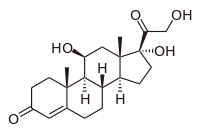
Photo from wikipedia
PurposeThe purpose of this study is to develop a new pharmacokinetic-pharmacodynamic (PK-PD) model to characterise the contribution of (S)- and (R)-warfarin to the anticoagulant effect on patients in treatment with… Click to show full abstract
PurposeThe purpose of this study is to develop a new pharmacokinetic-pharmacodynamic (PK-PD) model to characterise the contribution of (S)- and (R)-warfarin to the anticoagulant effect on patients in treatment with rac-warfarin.MethodsFifty-seven patients starting warfarin (W) therapy were studied, from the first dose and during chronic treatment at INR stabilization. Plasma concentrations of (S)- and (R)-W and INRs were measured 12, 36 and 60 h after the first dose and at steady state 12–14 h after dosing. Patients were also genotyped for the G>A VKORC1 polymorphism. The PK-PD model assumed a linear relationship between W enantiomer concentration and INR and included a scaling factor k to account for a different potency of (R)-W. Two parallel compartment chains with different transit times (MTT1 and MTT2) were used to model the delay in the W effect. PD parameters were estimated with the maximum likelihood approach.ResultsThe model satisfactorily described the mean time-course of INR, both after the initial dose and during long-term treatment. (R)-W contributed to the rac-W anticoagulant effect with a potency of about 27% that of (S)-W. This effect was independent of VKORC1 genotype. As expected, the slope of the PK/PD linear correlation increased stepwise from GG to GA and from GA to AA VKORC1 genotype (0.71, 0.90 and 1.49, respectively).ConclusionsOur PK-PD linear model can quantify the partial pharmacodynamic activity of (R)-W in patients contemporaneously exposed to therapeutic (S)-W plasma levels. This concept may be useful in improving the performance of future algorithms aiming at identifying the most appropriate W maintenance dose.
Journal Title: European Journal of Clinical Pharmacology
Year Published: 2017
Link to full text (if available)
Share on Social Media: Sign Up to like & get
recommendations!